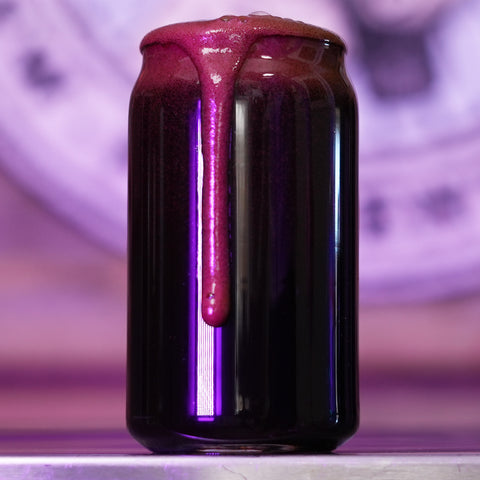
We have a special treat for you today. We're attempting to brew the world's darkest beer and we're joined by dark artist, Rob Czar. Rob had a brush with death several years back. While in recovery he learned to paint and dealt with his traumatic experience by painting in his basement. As you might imagine, the art, which is inspired by his frightening experience, is quite dark. So it only seemed natural to commission Rob to make the world's darkest label for the world's darkest beer!
We brewed this beer on Clawhammer's 10.5 gallon, 120 volt brewing system and we bought our ingredients from Asheville Brewer's Supply. And while we're doing links, here's the Czar Art studio. If you're not into reading, here's the darkest beer video. Otherwise, scroll on down!
Ingredients
We used a ton of dark malt for this beer - like, almost 20% of the grain bill is dark malt. We've never gone over 8%! So, a word of caution: this beer will need a bit of time to condition and age after fermentation. Otherwise it's going to be a bit rough around the edges.
Water
- 7.56 gallons of good ol' Asheville city water.
Grain
The key to making any beer dark is dark malt. Though, what most experienced brewers will tell you is that a little bit goes a long way. For example, a stout can be made to look convincingly dark with a grain bill comprised of only 4% dark malt. A Dry Irish Stout might be made with such a ratio and nobody will bat an eye at the finished product. The beer will, for all intents and purposes, look "black." So, if we're trying to make the darkest beer, how can we tell if it's really darker than a competing shade of "black!?"
The trained eye will be able to tell a really dark beer almost immediately. And it isn't determined by looking at the liquid in the bottom of the glass. The easiest way to tell how dark a beer really is is by looking at the "head." The head is the foam on top of the beer. The head on a glass of Guiness, for example, is almost white! So it's a dark stout, but it's not a really dark stout. Look at the head on the beer we've brewed. It's a very deep shade of brown.

Another way to determine the darkness of a beer is to test it with a flashlight. Light is easily shone through semi-dark beers. When we turned off all of the lights and tried to shine light through our beer, absolutely nothing passed through. That's how you can tell a beer is very, very dark.
Also, technically, there is a scale for judging beer darkness, called the Standard Reference Method (SRM) which can be calculated by brewing software. Without the cocoa powder, the SRM of our beer is 104. However, we added special Dutch "black cocoa" powder, which is heavily roasted and highly alkalized. Adding just a bit of this to cookie dough, for example, is enough to turn them black. With the addition of this the SRM is likely quite a bit higher, but we don't know how much.
So, exactly how did we brew the darkest beer in the world? As we mentioned, dark malts! Here's exactly what we used
- 6 lbs Vienna Malt
- 1 lb 4 oz Caramunich Malt
- 1 lb 4 oz Victory Malt
- 1 lb Black Malt
- 1 lb Chocoloate Malt
- 1 lb Chocolate Wheat Malt
- 1 lb Riverbend Base Camp Malt
- 9 oz Black Patent Malt
- 8 oz Carafa III Malt
Hops and Adjuncts
- 4 oz Saaz Hops
- 4 oz BlackCocoa Powder
Yeast
- 1 pkg Czech Budejovice Lager (White Labs #802)
Process
To make this beer we tried our best to follow the steps below. However, admittedly, we aren't great brewers. Heck, we might not even be good brewers. What we're trying to say is that you can probably do this better than we can, even with a minimal amount of effort. Good luck!

- Fill the kettle with water and begin heating to mash temp (152F).
- Grind the malt finely in a mill (.025 inches).
- Add a basket and stir the grain into the water once mash temp is met.
- Allow grain to steep for 1 hour.
- After steeping pull the basket (and the grain) from the liquid and heat to a boil.
- Once boiling, set a timer for 60 minutes and add 2 oz. of Saaz hops.
- With 10 minutes left in the boil, add 4 oz. of black cocoa powder.
- At the end of the boil, turn off the heat and add 2 oz. of Saaz hops.
- Chill to room temperature
- Transfer to a keg or a fermenter or a keg fermenter.
- Aerate with an O2 tank or by shaking for 120 seconds.
- Add yeast
- Add an air lock or a spunding valve
- Allow to ferment for 2 weeks.
- Chill and carbonate if kegging, or add to cans or bottles.
- Allow to age and condition for 3-4 weeks
- Serve and enjoy!
This was a super fun project and it was also the first time we made a real beer label for our cans. Well, Rob actually made the labels. They turned out great, wouldn't you say!?






Leave a comment